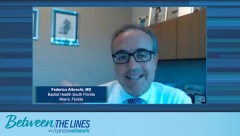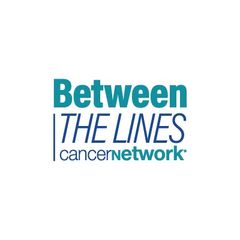
Presentation: Benefits and Limitations of RWE: Lessons From EGFR Mutation-Positive NSCLC
Dr. Lyudmila Bazhenova presents a recently published article by Nazha B, et al., “Benefits and limitations of real-world evidence: lessons from EGFR mutation-positive non-small-cell lung cancer.”
Episodes in this series

Lyudmila Bazhenova, MD: Hello everybody and good evening for some. I’d like to welcome you to the Cancer Network® program, “Between the Lines, Real-World Evidence in Non-Small Cell Lung Cancer.” Today’s feature article is “Benefits and limitations of real-world evidence: lessons from EGFR mutation-positive non-small-cell lung cancer. I am Dr. Lyudmila Bazhenova, thoracic medical oncologist from the University of California San Diego. I am joined by Dr. Federico Albrecht from Baptist Health South Florida, [Miami, Florida].
The paper that we’re going to be discussing today is by Nazha and colleagues and is a review paper. The aim of this review was to provide an overview of different types of real-world observational studies. They also discuss the benefits and the limitations of what we call the real-world evidence as a complementary clinical trial data and explain how such evidence can be used to help inform treatment decisions using example from observational studies in patients with epidermal growth factor receptor [EGFR] mutation-positive non-small cell lung cancer [NSCLC].
They did a literature review of real-world studies searching PubMed and ASCO [American Society of Clinical Oncology] congress abstracts, using search terms: real-world, observational, EGFR, non-small cell lung cancer. They collected those articles and out of that collection they selected certain papers based on their potential relevance to the topic or narrative review. Finally, they cross-checked the references for duplication of patient population, which is important.
These are the key features of randomized control clinical trials and real-world studies. When we practice we first refer to randomized clinical trials or prospective clinical trials. Real-world evidence recently came into view, and we’re starting to use this evidence a bit more frequently than before. It’s important for us to understand the difference between a randomized clinical trial and real-world studies. In this paper they come up with several categories.
The key purpose of the randomized clinical trials are to find out if the drug works, we’re asking for efficacy. In the real-world evidence we’re asking for effectiveness, which is efficacy in a real-world setting. Types of the studies; randomized control trials are interventional; real-world are observational; randomized are always prospective. Real-world studies can be both prospective and retrospective and there are strengths and weaknesses of both.
In patient population randomized clinical trials, it’s very homogeneous because they all have to meet a certain criteria to get in. In the real-world evidence, the patient population is diverse, and it’s more representative of what happens in real life.
For eligibility criteria, again, a randomized clinical trial is very strict. In the real-world evidence, you may not have eligibility criteria, you want to follow how your population did in the real practice. In randomized control trials treatments are generally fixed, prescribed by the clinical trial, and in the real-world setting and definitely it’s very bold. You might have a slightly different dosing, or different schedule.
Comparator arms—in randomized clinical trials we have some type of comparison. It’s either going to be standard of care or placebo controlled. In the real-world setting there is no direct comparator arm. In the real-world setting, they can compare how 2 different patient populations did, but it’s not a true comparator arm. Again, randomized clinical trials have randomization, real-world evidence do not. Blinding never happens in the real-world evidence; sometimes it happens in randomized clinical trial. Follow up is very strictly specified in randomized clinical trials. We know when the scan needs to be done, when the patient needs to have blood work done, when the EKG [electrocardiogram] needs to be done, and in the real-world evidence it basically flows as we go as per routine clinical practice.
In the randomized clinical trials, the physicians who take care of the patients are highly selective, but they are investigators, they have to pass a certain criteria, it should be a named investigator. In the real-world evidence it’s real physicians who take care of the patients, sometimes mid-level providers. Patient monitoring is very strict and prescribed. In a randomized clinical trial, we can’t do 1 step left, 1 step right. It has to be exactly by the books. Then in the real-world evidence the follow up and monitoring is certainly variable and different with different physicians and different practices.
What are the types of real-world studies that they highlighted in this paper? I’d like to look at that slide from the right side because we all start with case studies, and when we were fellows we published case studies, it’s the low evidence, real-world evidence data. One step above is going to be cohort studies where you report in a group of patients. And then 1 above is going to be post-marketing studies, which is studies that pharmaceutical companies agree to conduct at the request of the regulatory body. They are there to generate some additional real-world evidence where the patients are being treated in the real setting and may not meet the criteria or eligibility that we saw in clinical trials.
Then we have patient registries. In lung cancer, the most famous registry is the RET registry. Those type of studies are very useful to study a low incidence of diseases, and it’s usually organized systems that asks certain questions. Nowadays we see patients derive or patients driven registries. For example, in the EGFR space we have a registry of patients who develop small cell transformation which is organized by patients itself.
Then we have retrospective observational studies which we analyze historic data to look at specific outcomes, and they are more likely to be biased and confounding factors in prospective studies. The strongest real-world evidence data we can see is from prospective operational studies, which are designed to establish primary outcomes, and prespecified outcomes; patients are not randomized, and treatment is at the physician’s discretion. Because of its prospective there is some uniformity in data that is being collected on that clinical evidence.
Transcript edited for clarity.
Newsletter
Stay up to date on recent advances in the multidisciplinary approach to cancer.
















































































